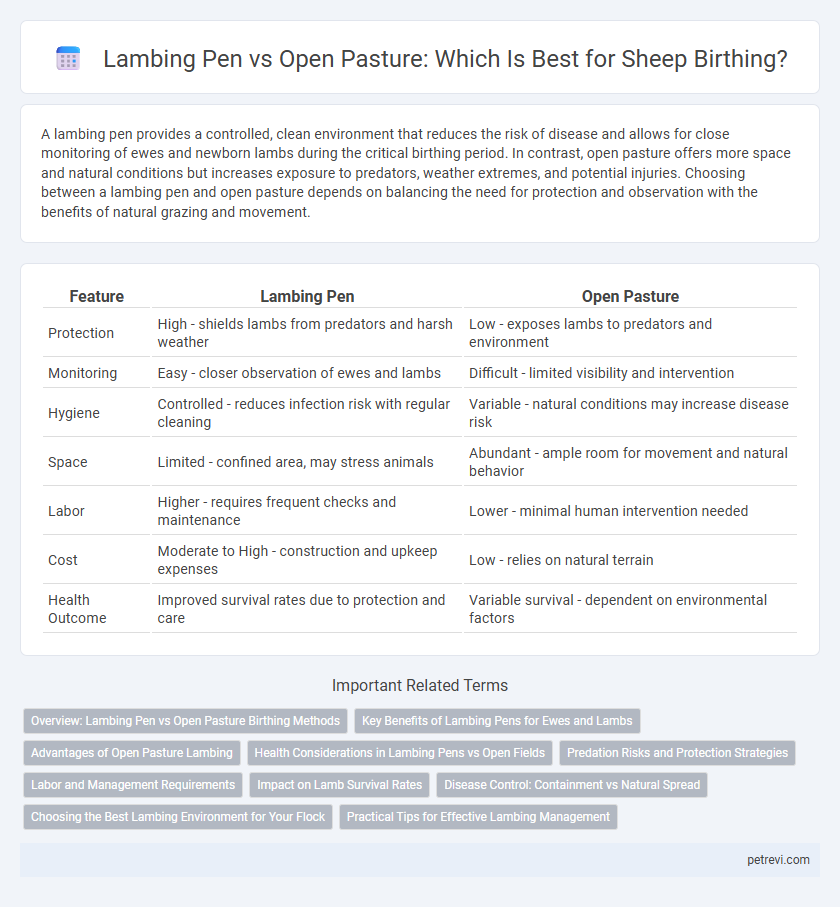A lambing pen provides a controlled, clean environment that reduces the risk of disease and allows for close monitoring of ewes and newborn lambs during the critical birthing period. In contrast, open pasture offers more space and natural conditions but increases exposure to predators, weather extremes, and potential injuries. Choosing between a lambing pen and open pasture depends on balancing the need for protection and observation with the benefits of natural grazing and movement.
Table of Comparison
| Feature | Lambing Pen | Open Pasture |
|---|---|---|
| Protection | High - shields lambs from predators and harsh weather | Low - exposes lambs to predators and environment |
| Monitoring | Easy - closer observation of ewes and lambs | Difficult - limited visibility and intervention |
| Hygiene | Controlled - reduces infection risk with regular cleaning | Variable - natural conditions may increase disease risk |
| Space | Limited - confined area, may stress animals | Abundant - ample room for movement and natural behavior |
| Labor | Higher - requires frequent checks and maintenance | Lower - minimal human intervention needed |
| Cost | Moderate to High - construction and upkeep expenses | Low - relies on natural terrain |
| Health Outcome | Improved survival rates due to protection and care | Variable survival - dependent on environmental factors |
Overview: Lambing Pen vs Open Pasture Birthing Methods
Lambing pens provide a controlled, clean environment that minimizes exposure to predators and harsh weather, promoting higher lamb survival rates. Open pasture birthing allows ewes more space and natural behavior but increases risks of lamb loss due to environmental factors and predation. Choosing between lambing pen and open pasture depends on flock size, management resources, and local climate conditions.
Key Benefits of Lambing Pens for Ewes and Lambs
Lambing pens provide a controlled, clean environment that reduces the risk of disease transmission and predation, promoting healthier outcomes for ewes and newborn lambs. They facilitate close monitoring and timely assistance during birthing, increasing lamb survival rates and minimizing ewe stress. Enclosed spaces also enable targeted feeding and warmth management, essential for the early development and well-being of lambs.
Advantages of Open Pasture Lambing
Open pasture lambing allows ewes to give birth in a natural environment that reduces stress and promotes maternal behavior, leading to higher lamb survival rates. It provides better ventilation and space, minimizing the spread of diseases common in confined lambing pens. The exposure to natural light and fresh air enhances immunity in both ewes and lambs, supporting healthier growth and development.
Health Considerations in Lambing Pens vs Open Fields
Lambing pens provide a controlled environment that reduces exposure to predators, harsh weather, and infectious agents, which lowers the risk of lamb mortality and disease transmission. Open pastures allow ewes to birth naturally with ample space but increase vulnerability to environmental stressors, parasites, and difficulty in monitoring weak or ill lambs. Health management in lambing pens includes regular sanitation, restricted access to minimize contamination, and close observation, leading to better neonatal care and improved survival rates compared to open-field birthing.
Predation Risks and Protection Strategies
Lambing pens provide a controlled environment that significantly reduces predation risks by limiting access to predators through secure fencing and sheltering, crucial during the vulnerable birthing period. Open pastures expose ewes and newborn lambs to greater threats from coyotes, foxes, and other predators, necessitating active protection measures such as guard animals, motion-activated lights, and nighttime monitoring. Effective predator management combines physical barriers and vigilant supervision to safeguard lambs' survival rates during the critical early weeks post-birth.
Labor and Management Requirements
Lambing pens provide a controlled environment that simplifies monitoring during labor, reducing stress and enabling timely assistance for ewe complications. Open pastures require vigilant, continuous observation to manage unpredictable labor conditions and protect newborn lambs from predators and harsh weather. Effective management in open pastures demands more labor resources compared to the structured care possible within lambing pens.
Impact on Lamb Survival Rates
Lambing pens enhance lamb survival rates by providing a controlled environment that reduces predator access, limits exposure to harsh weather, and allows close monitoring of ewes during birthing. Open pastures offer natural conditions but increase risks such as lamb predation, exposure to elements, and difficulty in timely intervention. Studies indicate survival rates improve significantly when lambing pens are used, especially in regions with high predator populations or unpredictable weather patterns.
Disease Control: Containment vs Natural Spread
Lambing pens provide controlled environments that significantly reduce the risk of disease transmission by isolating ewes and newborn lambs, facilitating targeted hygiene management and monitoring. In contrast, open pastures increase the likelihood of pathogen spread due to unrestricted contact among animals and exposure to contaminated soil or feces. Implementing lambing pens supports effective containment and minimizes outbreaks of infectious diseases such as foot rot, coccidiosis, and mastitis during the critical birthing period.
Choosing the Best Lambing Environment for Your Flock
Selecting the ideal lambing environment significantly impacts lamb survival rates and ewe comfort. Lambing pens provide controlled protection from predators and harsh weather, reducing stress and facilitating close monitoring during birth. Open pastures offer natural space and ventilation but increase exposure to environmental dangers and complicate immediate intervention in case of lambing difficulties.
Practical Tips for Effective Lambing Management
Lambing pens provide controlled environments that minimize lamb mortality by protecting ewes and newborns from predators, harsh weather, and ewe-to-ewe aggression, making it easier to monitor birthing progress and intervene when necessary. Open pastures allow for natural behavior and reduced labor costs but require vigilant observation and adequate shelter to prevent exposure-related stress and complications during lambing. Effective lambing management includes maintaining clean, dry bedding in pens, regular health checks, and ensuring that ewes have access to nutrition and water regardless of the chosen lambing environment.
Lambing Pen vs Open Pasture for Sheep Birthing Infographic

 petrevi.com
petrevi.com